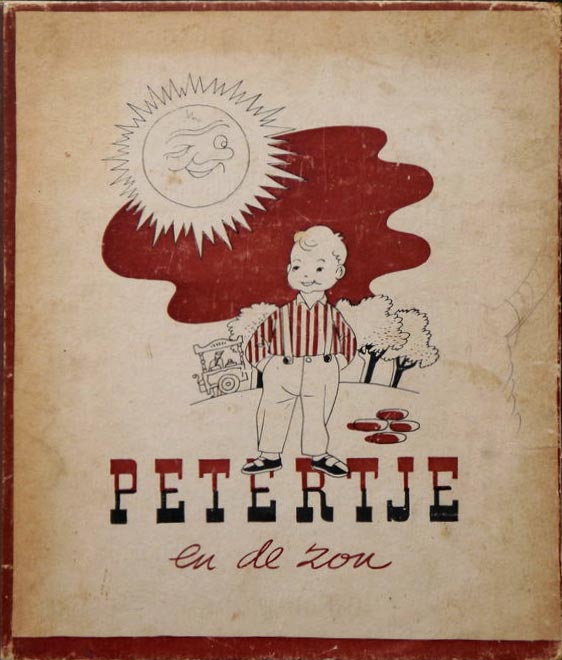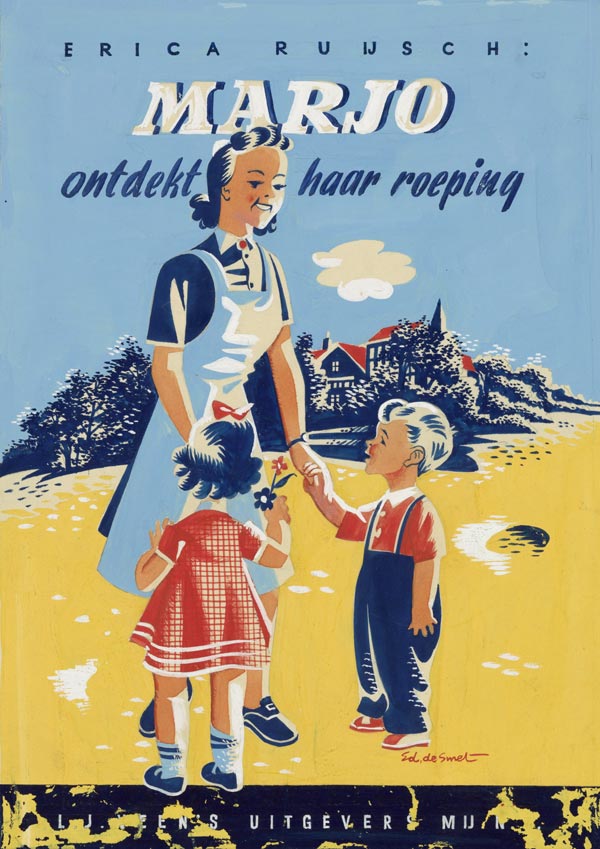Eddy de Smet was a Dutch illustrator and studio manager. With offices in Amsterdam, The Hague, Brussels and Antwerp, his firm Van Maanen was one of the most important Dutch advertising agencies, eventually forcing De Smet into the role of manager instead of artist. Nowadays, his fame is largely overshadowed by that of his son, the legendary Dutch comic artist Peter de Smet (1944-2003).
Early life & career
Eduard de Smet was born in 1917 in Amsterdam, where grew up in the rough Zeedijk area among the prostitutes and drunken sailors. The young man quickly became streetwise, and had his first job helping out in the family sandwich bar. A trip to the employment office propelled his career into an artistic direction. He was hired as an apprentice by a local advertising painter. He then became an errand boy at the Amsterdam-based advertising firm De La Mar, where he was further trained by the artist Eppo Doeve. De La Mar also marked the beginning of his lifelong friendship and association with copywriter Cor Brandt.
Illustrated retelling of 'De Rogstekers van Weert' in Panorama #35, 1941.
Van Maanen
During the end of World War II, De Smet resigned from De La Mar and opened his own studio with Brandt, called Studio De Smet-Brandt. Together they worked on assignments from local department stores like De Bijenkorf, V&D and Gerzon, but they also developed party games. In 1947, De Smet and Brandt bought the small advertising firm of G.F. van Maanen, who had recently died in a motorcycle accident. With his understanding of commercial matters, Eddy de Smet was assigned with acquiring new clients and designing the campaigns, while Brandt took care of the texts.
Comic strip-like drawings for Van Maanen (client unknown).
Graphic contributions
In addition to his advertising work, Eduard de Smet had illustrations published in Panorama magazine, including an illustrated retelling of the legend 'De Rogstekers van Weert' (1941). To celebrate the birth of his oldest son Peter, he wrote and illustrated the children's book 'Petertje en de zon' (L.J. Veen's Uitgeversmaatschappij, 1946). De Smet also provided the illustrations for the children's book 'Marjo ontdekt haar roeping' (L.J. Veen, 1946) by Erica Ruijsch (Max van Amstel). De Smet was in 1946 additionally involved as illustrator/designer with the early issues of the advertising trade journal Ariadne.
'Petertje en de Zon' and 'Marjo Ontdekt Haar Roeping'.
Success
Under their joint reign, Van Maanen expanded with new clients like Bols, Niemeyer, Whiskas, Procter & Gamble and Shell. The firm moved from the Nieuwezijds Voorburgwal to a larger building at the Oudezijds Voorburgwal, while an additional office was opened in The Hague, where Jan de Bruijn was in charge of all activities with regard to their top client Shell. In the early 1960s, the Amsterdam team settled in a former granary at the Barentszplein, the Amsterdam Westerdokhuis, where they were joined by the The Hague personnel shortly afterwards. Around this time, Van Maanen also opened a division in Brussels, Belgium. With the responsibility for one of the top three Dutch advertising firms, Eddy de Smet slowly turned from artist to business man. He used his sparse moments at home to make absurd and humorous drawings, including a humorous comic strip called 'De Wijze Kater'. The artwork for Van Maanen's clients was now handled by a range of freelance illustrators, including Jan Kruis, Fiep Westendorp and Joost Rietveld. In the mid-1960s, Eddy de Smet's son Peter also began his career at Van Maanen.
Olidin
One of the best-remembered productions of Van Maanen was Olidin (1957-1963), a children's magazine by commission of petrol company Shell. It was distributed freely among members of the Shell Junior Club, and contained puzzles, stories and many comics. Besides the title series by Friso Henstra, Olidin published work by established authors such as Hans G. Kresse ('Roland de jonge jager', 'Pim en de Venusman'), Carol Voges ('Opa') and Piet Wijn ('De Zwarte Hertog'). Van Maanen's own artists were also represented. Jan Kruis produced 'Tommy', 'Baldino', 'De Kleine Hertog' and 'Stientje en Gertje', for which he was assisted by Jan van der Voo and Wim Giesbers. Kruis' future publisher Joop Wiggers did lay-outs, production work and illustrations. Other important contributors to Olidin were Emile Brumsteede, Wim Giesbers, Frits Godhelp, Friso Henstra, Niek Hiemstra, Hans G. Kresse, Jan Kruis, Ted Mathijsen, Joost Rietveld, Chris Roodbeen, Jan van der Voo, P. Visser, Dick Vlottes, Carol Voges, Joop Wiggers and Piet Wijn.
Final years and death
The American advertising firm Ogilvy & Mather took a controlling interest in Van Maanen in 1970. At that point, the company employed 140 people and had a turnover of 30 million guilders. Eduard de Smet remained affiliated with his former company until late 1976, and passed away in Bergen in 2001. His life and work is largely described by Mariella Sormani in the dossier included in the first volume of Peter de Smet's 'De Generaal Gaat Integraal' collection (Personalia, 2018).










